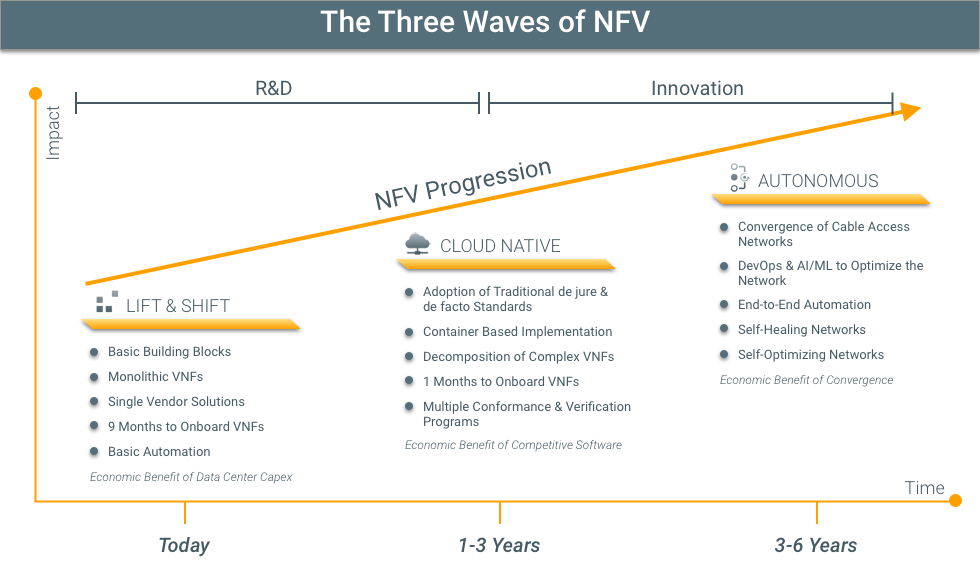Virtualization
CableLabs Announces SNAPS-Kubernetes

Today, I’m pleased to announce the availability of SNAPS-Kubernetes. The latest in CableLabs’ portfolio of open source projects to accelerate the adoption of Network Functions Virtualization (NFV), SNAPS-Kubernetes provides easy-to-install infrastructure software for lab and development projects. SNAPS-Kubernetes was developed with Aricent and you can read more about this release on their blog here.
In my blog 6 months ago, I announced the release of SNAPS-OpenStack and SNAPS-Boot, and I highlighted Kubernetes as a future development area. As with the SNAPS-OpenStack release, we’re making this installer available while it's still early in the development cycle. We welcome contributions and feedback from anyone to help make this an easy-to-use installer for a pure open source and freely available environment. We’re also releasing the support for the Queens release of OpenStack—the latest OpenStack release.
Member Impact
The use of cloud-native technologies, including Kubernetes, should provide for even lower overhead and an even better-performing network virtualization layer than existing virtual machine (VM)-based solutions. It should also improve total cost of ownership (TCO) and quality of experience for end users. A few operators have started to evaluate Kubernetes, and we hope with SNAPS-Kubernetes that even more members will be able to begin this journey.
Our initial total cost of ownership (TCO) analysis with a virtual Converged Cable Access Platform (CCAP) core distributed access architecture (DAA) and Remote PHY technology has shown the following improvements:
- Approximately 89% savings in OpEx costs (power and cooling)
- 16% decrease in rack space footprint
- 1015% increase in throughput
We anticipate that Kubernetes will only increase these numbers.
Three Waves of NFV
SNAPS-Kubernetes will help deliver Virtual Network Functions (VNFs) that use fewer resources, are more fault-tolerant and quickly scale to meet demand. This is a part of a movement coined “cloud native.” This the second of the waves of NFV maturity that we are observing.
With the adoption of NFV, we have identified three overarching trends:
- Lift & Shift
- Cloud Native
- Autonomous Networks
Lift & Shift
Service providers and vendors typically support the Lift & Shift model today. These are large VMs running on an OpenStack-type Virtualized Infrastructure Manager (VIM). This is a mature technology, and many of the gaps in this area have closed.
VNF vendors often brag that their VNF solution runs the same version of software that runs on their appliances in this space. Although achieving feature parity with their existing product line is admirable, these solutions don’t take advantage of the flexibility and versatility that can be achieved by fully leveraging virtualization.
There can be a high degree of separation between the underlying hardware and operating system from the VM. This separation is great for portability, but it comes at a cost. Without some level of hardware awareness, it isn’t possible to take full advantage of acceleration capabilities. An extra layer of indirection is included, which can add latency.
Cloud Native
Containers and Kubernetes excel in this quickly evolving section of the market. These solutions aren’t yet as mature as OpenStack and other virtualization solutions, but they are lighter weight and integrate software and infrastructure management. This means that Kubernetes will scale and fail over applications, and the software updates are also managed.
Cloud native is well suited for edge and customer-premises solutions where compute resources are limited by space and power.
Autonomous Networks
Autonomous networks are the desired future in which every element of the network is automated. High-resolution data is being evaluated to continually optimize the network for current and projected conditions. The 3–6-year projection for this technology is probably a bit optimistic, but we need to start implementing monitoring and automation tools in preparation for this shift.
Features
This release is based on Kubernetes 1.10. We will update Kubernetes as new releases stabilize and we have time to validate these releases. As with SNAPS-OpenStack, we believe it’s important to adopt the latest stable releases for lab and evaluation work. Doing so will prepare you for future features that help you get the most out of your infrastructure.
This initial release supports Docker containers. Docker is one of the most popular types of containers, and we want to take advantage of the rich ecosystem of build and management tools. If we later find other container technologies that are better suited to specific cable use cases, this support may change in future releases.
Because Kubernetes and containers are so lightweight, you can run SNAPS-Kubernetes on an existing virtual platform. Our Continuous Integration (CI) scripts use SNAPS-OO to completely automate the installation on almost any OpenStack platform. This should work with most OpenStack versions from Liberty to Queens.
SNAPS-Kubernetes supports the following six solutions for cluster-wide networking:
- Weave
- Flannel
- Calico
- Macvlan
- Single Root I/O Virtualization (SRIOV)
- Dynamic Host Configuration Protocol (DHCP)
Weave, Calico and Flannel provide cluster-wide networking and can be used as the default networking solution for the cluster. Macvlan and SRIOV, however, are specific to individual nodes and are installed only on specified nodes.
SNAPS-Kubernetes uses Container Network Interface (CNI) plug-ins to orchestrate these networking solutions.
Next Steps
As we highlighted before, serverless infrastructure and orchestration continue to be future areas of interest and research. In addition to extending the scope of our infrastructure, we are focusing on using and refining the tools.
Multiple CMTS vendors have announced and demonstrated virtual CCAP cores, so this will be an important workload for our members.
Try It Today
Like other SNAPS releases, SNAPS-Kubernetes is available on GitHub under the Apache Version 2 license. SNAPS-Kubernetes follows the same installation process as SNAPS-OpenStack. The servers are prepared with SNAPS-Boot, and then SNAPS-Kubernetes is installed.
Have Questions? We’d Love to Hear from You
- Reach out on IRC: Server: Freenode Channel #cablelabs-snaps
- Contribute to the documentation, backlog and code on GitHub
- Send an email message directly to snaps@cablelabs.com
- Tweet to @RandyLevensalor
Subscribe to our blog to learn more about SNAPS in the future.



